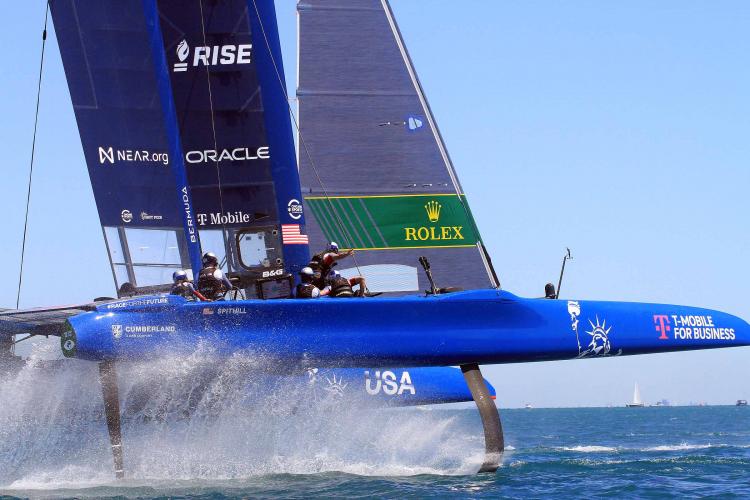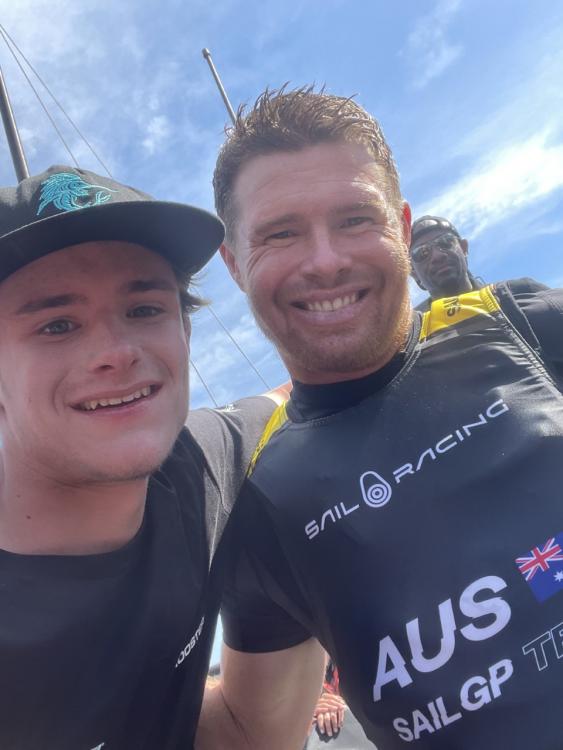Australia Wins T-Mobile United States Sail GP Event at Navy Pier Chicago, US Team Finishes a Disappointing 7th
The Windy City lived up to its name this past weekend as 9 SailGP teams lined up for their first-ever freshwater event, part of a now 3-year-old high-octane supercharged foiling 50-foot catamaran international series.
The wind blustered on both sides of the breakwater that protected the racecourse from 3–5-foot waves. While conditions were fluky at times, the roster of high-profile skippers (including three past and future America’s Cup skippers) was able to keep their high-flying boats airborne for an average of 97 percent of the time on day one, making for speeds of more than 40 MPH as the fleet maneuvered around the tight racecourse in less than 10 minutes per race. Wind speeds lessened to around 10 knots on day two, forcing the race to be held beyond the breakwater ringing Chicago’s Harbor where it was felt there was more wind. In the end, it was a familiar refrain as Tom Slingsby skippered Team Australia to an exciting final race that had the capacity crowd of more than 5000 land-based and 2000 water-based spectators glued to their seats as the boats blasted towards the finish line.

The Australian team finished day one of the racing in fourth place. In the first race of the second day, they finished dead last. It took a win on the last race to catapult the two-time series champions into the final race of the day. Taking advantage of a strong start, the Aussies cruised to victory over an overmatched Great Britain and Canadian team. Once again, the Aussies came from a spot in the middle of the pack on day one to thrill their fans with a stellar performance when all the marbles were on the line. “We don’t plan to do it that way,” a smiling Slingsby said at the prize giving ceremony. “But we always find a way to fight through it and so far we’ve come up on top.”
Jimmy Spithill, Sail GP Team USA CEO and skipper, was matter of fact in post-race interviews. “No excuses,” the former Americas’ Cup skipper said. “I want to apologize to all the family and friends, and all the spectators who were supportive of us the whole way through this weekend, irrespective of how badly we sailed in the first four races,” he said. “The crowd has been incredible and Chicago more than delivered on all fronts.”

What’s next for the United States team? Spithill put it in perspective like this: “Look, we've got two options right now. We can either sort of curl up and cry ourselves to sleep tonight or we can say right now let's learn the lessons and not throw the towel in.," Spithill said. "That’s exactly what the team will do. Good thing that it’s a long season. We've got to come out swinging for the next one and just start climbing back up the board.”
Eighteen-year-old CJ Perez served as tactician for the US team. “Calling tactics on the racecourse this tight was a challenge,” she said. “One little mistake at the start and you’re playing catchup the whole race. “Each SailGP team includes a female athlete on the competitive crew. Most teams elect to delegate a tactical role to the female athletes. Some other teams have experimented with assigning the flight controller role to the females. When the teams include 6 members, CJ will take over driving while Spithill moves to the other side of the boat during tacking situations.
League founder New Zealand’s Sir Russell Coutts was ecstatic about the Chicago event. “This is what we envisioned when we launched the league three years ago,” he told me in an exclusive interview. “We now have 9 teams. More to come next year. We have the word’s best sailors…and a growing number of international fans. Our Finale last March drew over 10 million viewers from all media. Sail GP is big…and getting bigger.”
The Navy Pier venue was perfect for the short-track races. Fans crowded the seawall and sat on bleachers watching the action that, at least on day one, was unfolding mere yards from their vantage point. At the start, boats jockeyed for position outside the seawall, then came barreling down to the course for the gun. The up and back short course finished right in front of the crowd. On day two, the racing was moved to beyond the breakwater, lessening the fans’ ability to catch all the action live. But they were kept up to date by a running video feed shown on a giant TV screen. Commentary from on-board tacticians brought the race to life. Fans waved flags and shouted encouragement to their teams. “We could definitely hear the cheers from the crowd,” said CJ Perez. “It was awesome.”

The SailGP circuit moves to Plymouth, England July 30-31st for the third race of the 11-race season. Presently, Australia leads the series, followed by Canada and Great Britain. The US team sits at 7th in the 9-team fleet. The teams are competing not only for bragging rights, but also for a million-dollar purse to be awarded to the overall winner following the Grand Finale event May 6-7 in San Francisco.
Story and photos by Craig Ligibel




